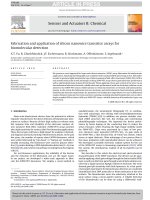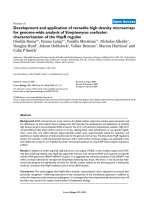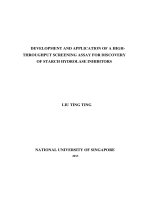Development and application of computational methods and tools for adverse drug reaction and toxicity prediction
Bạn đang xem bản rút gọn của tài liệu. Xem và tải ngay bản đầy đủ của tài liệu tại đây (3.7 MB, 214 trang )
DEVELOPMENT AND APPLICATION OF
COMPUTATIONAL METHODS AND TOOLS FOR
ADVERSE DRUG REACTION AND TOXICITY
PREDICTION
HE YUYE
(B.Sc. (Hons.), NUS)
A THESIS SUBMITTED
FOR THE DEGREE OF DOCTOR OF PHILOSOPHY
DEPARTMENT OF PHARMACY
NATIONAL UNIVERSITY OF SINGAPORE
2013
i
DECLARATION
I hereby declare that this thesis is my original work and it has been written by me
in its entirety.
I have duly acknowledged all the sources of information which have been used in
the thesis.
This thesis has also not been submitted for any degree in any university
previously.
__________________
He Yuye
24 Mar 2014
i
Acknowledgements
First and foremost, I would like to express the deepest gratitude to my supervisor,
Dr Yap Chun Wei, who provides me with excellent guidance and insightful
advices throughout my PhD study. I have tremendously benefited from his
profound knowledge, expertise in research and continuous support. I would like to
thank him and give my best wishes to him and his family.
I am also very grateful to National University of Singapore for the reward
of research scholarship and Department of Pharmacy for the support of all
resources and opportunities.
In addition, I am very appreciative of my PhD committee members for
their insights and advices to improve my research. I would like to thank all
present and previous PaDEL group members for their valuable discussions and
help, as well as the SMP, SRP and SCIENTIA students for their contributions in
the adverse drug reaction prediction projects.
Lastly, I am profoundly grateful to my family, especially my dearest
husband for their understanding and encouragement.
He Yuye
Aug 2013
ii
Table of Contents
Acknowledgements i
Table of Contents ii
List of Tables viii
List of Figures x
List of Publications xi
List of Abbreviations xii
Chapter 1 Introduction 1
1.1. ADMET studies in drug discovery and development 1
1.2. QSAR studies for ADR and toxicity prediction 2
1.3. Limitations of current QSAR studies 6
1.4. Objectives and significance 10
1.5. Thesis structure 11
Chapter 2 Materials and methods for model development 14
2.1. Endpoints and datasets 14
2.1.1. SJS/TEN 15
2.1.2. TdP 16
2.1.3. Serious psychiatric ADRs 18
2.2. QSAR process 19
2.2.1. Introduction 19
2.2.2. Data curation 20
2.2.3. Molecular descriptors 21
2.2.4. Data preprocessing 23
2.2.5. Model development 24
2.2.6. Model validation/evaluation 28
2.2.7. Applicability domain 30
2.2.8. Ensemble modeling 31
2.2.9. Performance evaluation 32
Chapter 3 One-Class Classification 35
3.1. Introduction 35
3.2. Materials and methods 37
3.2.1. OCC methods 37
3.2.2. Application of OCC methods in real studies 42
3.3. Results 45
3.3.1. SJS/TEN study 45
3.3.2. TdP study 46
iii
3.3.3. Serious psychiatric ADR study 47
3.4. Discussion 48
3.4.1. OCC methods 48
3.4.2. Performances of OCC models 49
3.5. Conclusion 51
Chapter 4 Addition of biological information 52
4.1. Introduction 52
4.1.1. QSAR modeling 54
4.1.2. Toxicogenomics 55
4.1.3. Integrative study using both QSAR and TGX methods 56
4.2. Materials and methods 58
4.2.1. Data 58
4.2.2. Methods 59
4.2.3. Model development and validation 61
4.2.4. Ensemble modeling 62
4.3. Results and discussion 62
4.3.1. Discussion of models 62
4.3.2. Discussion of methods 64
4.4. Conclusion 65
Chapter 5 Applicability domain 66
5.1. Introduction 66
5.2. Methods 70
5.2.1. AD for base model 70
5.2.2. AD for ensemble model 72
5.3. Testing of DT AD method 72
5.3.1. Dataset 72
5.3.2. Methods 73
5.3.3. Results and discussion 74
5.4. Conclusion 76
Chapter 6 Ensemble modeling 77
6.1. Introduction 77
6.2. Methods 80
6.2.1. DisEnsemble method 80
6.2.2. Genetic algorithm 82
6.2.3. Model fusion 83
6.3. Results 83
6.3.1. Base and ensemble model performances for SJS/TEN study 83
6.3.2. Base and ensemble model performances for TdP study 84
iv
6.3.3. Base and ensemble model performances for serious psychiatric ADR
study 86
6.4. Discussion 86
6.4.1. Model pool size and ensemble size 86
6.4.2. Performance of best base models and best ensemble models 87
6.4.3. Selection of two ensemble methods 89
6.5. Conclusion 89
Chapter 7 Development of model evaluation method 91
7.1. Introduction 91
7.2. Materials and methods 92
7.2.1. Data sets and tools 92
7.2.2. RS and CV method experiment 93
7.2.3. ADVal method experiment 95
7.2.4. Determination of representativity 97
7.2.5. Model development 98
7.2.6. Performance profile comparison 98
7.3. Results and discussion 99
7.3.1. Results of CV and RS validation experiment 99
7.3.2. Results of ADVal experiment 101
7.3.3. Comparison of the correlation results of three validation methods 103
7.4. Conclusion 107
Chapter 8 Summary of Models 109
8.1. Introduction 109
8.2. SJS/TEN model 109
8.2.1. Results 110
8.2.2. Discussion 113
8.3. TdP model 117
8.3.1. Results 118
8.3.2. Discussion 120
8.4. Serious psychiatric ADR model 122
8.4.1. Data summary 122
8.4.2. Results 124
8.4.3. Discussion 125
8.5. Model for nephrotoxicity 127
8.5.1. Important features 128
8.6. Conclusion 129
Chapter 9 Tool for model deployment 132
9.1. Introduction 132
9.2. Materials and methods 136
v
9.2.1. Design choices 136
9.2.2. Implementation details 138
9.2.3. Experiment 142
9.3. Results and discussion 142
9.3.1. Currently available models 142
9.3.2. Comparison with other in silico PD-PK-T tools 144
9.3.3. Experiments for computation time 146
9.4. Conclusion 146
Chapter 10 Conclusions 149
10.1. Major findings and contributions 149
10.1.1. Findings of methods 149
10.1.2. Findings of models 150
10.1.3. Findings of tools 150
10.2. Limitations and suggestions for future studies 151
10.2.1. Limitations and suggestions of data 151
10.2.2. Limitations and suggestions of methods 151
10.2.3. Limitations and suggestions of models 153
10.2.4. Limitations and suggestions about tools 154
Bibliography 156
Appendix 186
vi
Summary
Drug discovery and development aims to provide therapeutic compounds
that are safe and effective in improving the quality of life and relieving pain of
patients. However, the process is usually complex, time consuming and resource
intensive. Toxicity is one of the primary reasons for the failure of drug candidates
in later stages of drug development. Moreover, adverse drug reaction (ADR)
during post-approval stage is among the leading causes of morbidity and mortality.
Computational methods such as quantitative structure-activity relationship
(QSAR) methods have been explored as complementary methods for predicting
and profiling toxicities and have shown promising result for performing these
tasks. Nevertheless, there are still limitations for current QSAR modeling process
which affect the quality and prevent the application of QSAR models. These
include lack of negative data and descriptors, difficulties in determination of
applicability domain (AD), lack of effective model selection method for ensemble
modeling, lack of proper model evaluation method and tool for model application.
This thesis attempts to address these issues with various strategies
including: using OCC methods to address the lack of negative data issue, adding
biological information as extra descriptors, developing methods for AD
determination, model selection and model evaluation, and developing a software
program to facilitate the application of QSAR models. Some of these strategies
were applied in real data sets to develop QSAR models to facilitate the detection
of drug candidates with propensity of toxicity and ADRs. Three types of rare
and/or serious ADRs including Stevens Johnson’s syndrome/toxic epidermal
necrolysis (SJS/TEN), Torsade de pointes (TdP) and serious psychiatric ADRs
were investigated. Another predictive study regarding nephrotoxicity was also
carried out to explore the possibility of integrating toxicogenomics (TGX) method
with QSAR method to enhance the model’s prediction ability as well as biological
understanding. The results showed that the development and application of QSAR
models could be improved by using the methods discussed in this work. The
QSAR models for the ADRs are the first to address these endpoints with
comprehensive and reliable methods and the performances are also encouraging.
vii
The integrated model developed using both QSAR and TGX methods for
nephrotoxicity prediction demonstrated the potential of addition of biological
information. Lastly, a software program which provides well validated models for
prediction of ADMET properties was developed to facilitate the application of
QSAR models. The software possessed many advantages over other similar
software programs and it is completely free to the public.
The main purpose of this thesis is to develop and apply computational
methods and tools for ADR and toxicity prediction. The methods developed in
this work are potentially useful for development and application of QSAR models
as well as general predictive models other than pharmaceutical area. The models
developed for ADRs and toxicity could be applied in drug discovery and clinical
practice. The independent tool developed by integration of peer reviewed models
also provides an option for users to obtain reliable ADMET predictions.
viii
List of Tables
Table 1.1 Recent QSAR studies of ADR and Toxicity Prediction 5
Table 3.1 Performances of best base models from external 5-fold cross validation
for SJS/TEN study. 46
Table 3.2 Performances of best base models from external 5-fold cross validation
for TdP study 47
Table 3.3 Performances of best base models from external 5-fold cross validation
of the serious psychiatric ADR study. 48
Table 4.1 Some predictive studies of toxicities based on biological information. 54
Table 4.2 Performance of four types of ensemble models from 5-fold external
cross validation. 62
Table 5.1 Current AD determination methods 67
Table 6.1 Performances of best base models and best ensemble models for
SJS/TEN study. 84
Table 6.2 Performances of best base models and best ensemble models for TdP
study. 85
Table 6.3 Performances of best base models and best ensemble models for serious
psychiatric ADR study. 86
Table 7.1 Performance profile of SVM models on testing and validation set for
AM data from CV and RS experiment. 100
Table 7.2 Correlation coefficients of performance profiles of different models on
testing and validation sets using CV and RS method. CC_AUC, CC_SE and
CC_SP indicate the correlation coefficient of AUC, SE and SP values of testing
and validation performance respectively. 101
Table 7.3 Correlation coefficients of performance profiles using ADVal method
for three datasets. CC_AUC, CC_SE and CC_SP indicate the correlation
coefficient of the AUC, SE and SP values of testing and validation performance
respectively. 102
Table 8.1 Performances of the final ensemble model EM
all
. 110
Table 8.2 Top 13 potential important SMARTS substructures related to SJS/TEN.
112
Table 8.3 Compounds collected from literatures with recent SJS/TEN case reports.
117
Table 8.4 Performance of the final ensemble model EM
all
. 118
Table 8.5 Top 10 potential important SMARTS substructures related to TdP. 119
ix
Table 8.6 List of 25 critical terms listed in WHO-ART under code 0500
(psychiatric disorders) for the system-organ class. 123
Table 8.7 Performance of final EMall model for serious psychiatric ADR study.
124
Table 8.8 Prediction results for the perspective validation set. 125
Table 8.9 Distribution of therapeutic groups of the 321 drugs that cause top seven
serious psychiatric ADRs. 126
Table 8.10 Top ranking genomic feature and chemical descriptors. 128
Table 9.1 Free and/or open-source in silico tools for prediction of ADMET
properties 135
Table 9.2 Information of methods used for the development of available models
in PaDEL-DDPredictor. 143
x
List of Figures
Figure 1.1 General QSAR workflow, limitations and proposed methods. 7
Figure 2.1 An example of a simple feed forward network. 27
Figure 3.1 Graphical illustration of one-class SVM 38
Figure 3.2 Graphic illustration of basic idea of LOF. 39
Figure 3.3 General workflow of model development and validation. 43
Figure 4.1 Overview of model development for nephrotoxicity study. 60
Figure 5.1 Workflow of determination of optimal thresholds. 71
Figure 5.2 Workflow for model development. 73
Figure 5.3 Prediction accuracy of SVM, NB and RF models on samples within
and out of AD for training and testing set. T_IN_ACC and T_OUT_ACC are the
accuracy of the model on samples within and out of AD for training set
respectively. Similarly, V_IN_ACC and V_OUT_ACC are the accuracy of the
model on samples within and out of AD for validation set respectively. 75
Figure 7.1 Workflow of CV and RS method. 95
Figure 7.2 Workflow of ADVal. 96
Figure 7.3 Correlation coefficients of AUC, SE and SP values for ADVal
experiments for all datasets. The number 1 to 10 is the bin index. AM_CC_AUC,
AM_CC_SE and AM_CC_SP indicate the correlation coefficient of AUC, SE and
SP values of testing and validation performance for AM data set respectively. The
same notation rule applies for MAGIC and PC dataset. 105
Figure 8.1 Score plots of PCA for model EM
all
on internal CV result. The ST
+
and
ST
-
drugs are shown with black and grey dots respectively. Drugs outside the AD
of EM
all
are marked with “x”. For better visualization, only eight representative
drugs are marked with their names. 111
Figure 9.1 Screenshot of PaDEL-DDPredictor interface: Setting page 140
Figure 9.2 Screenshot of PaDEL-DDPredictor interface: Models page 141
Figure 9.3 Computation time of prediction on 1000 compounds. 142
xi
List of Publications
1. He Y, Chu S, Yap CW. Prevalence of serious psychiatric adverse
reactions in marketed drugs and development of a computational model to
predict such adverse reactions. Submitted.
2. He Y, Chong FHT, Lim J, Lee RJT and Yap CW (2013). Determination of
potential of drug candidates to cause severe skin disorders using
computational modeling. Molecular Informatics. 32 (3): 303-312.
3. He Y, Liew CY, Sharma N, Woo SK, Chau YT and Yap CW (2013).
PaDEL-DDPredictor: Open-source software for PD-PK-T prediction.
Journal of Computational Chemistry. 34 (7): 604-610.
4. He Y, Lim SWY and Yap CW (2012). Determination of torsade-causing
potential of drug candidates using one-class classification and ensemble
modeling approaches. Current Drug Safety. 7 (4): 298-308.
xii
List of Abbreviations
ACC - accuracy
AD - applicability domain
ADMET - absorption, distribution, metabolism, excretion, toxicity
ADR - adverse drug reaction
ANN - artificial neural network
ATC - anatomical therapeutic chemical
AUC - area under curve
BM - base model
CPSA - charged partial surface area descriptors
CV - cross validation
DT - double threshold
EM - ensemble model
EPA - Environmental Protection Agency
E-state - electrotopological state
FAERS - FDA Adverse Event Reporting System
FDA - Food and Drug Administration
hERG - human ether-à-go-go-related gene
KNN - k-nearest neighbor
MCC - Matthews correlation coefficient
MDE - molecular distance edge descriptors
MLFER - molecular linear free energy relation descriptors
MV - majority voting
NCE - new chemical entities
NB - naïve Bayes
OCLOF - one-class local outlier factor
OCPD - one-class probability density
OCSVM - one-class support vector machine
OECD - Organization for Economic Co-operation and Development
PCA - principle component analysis
PPV - positive predictive value









